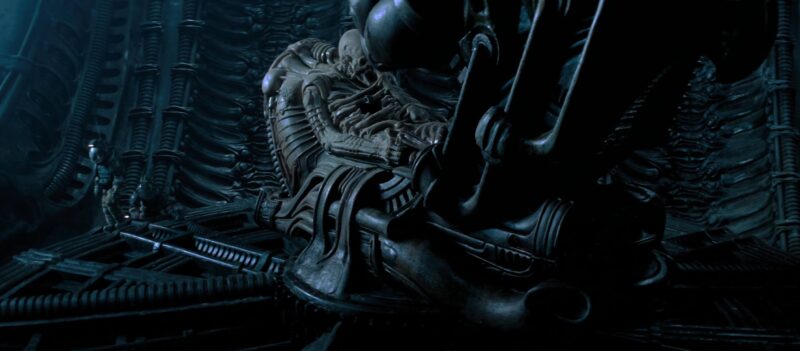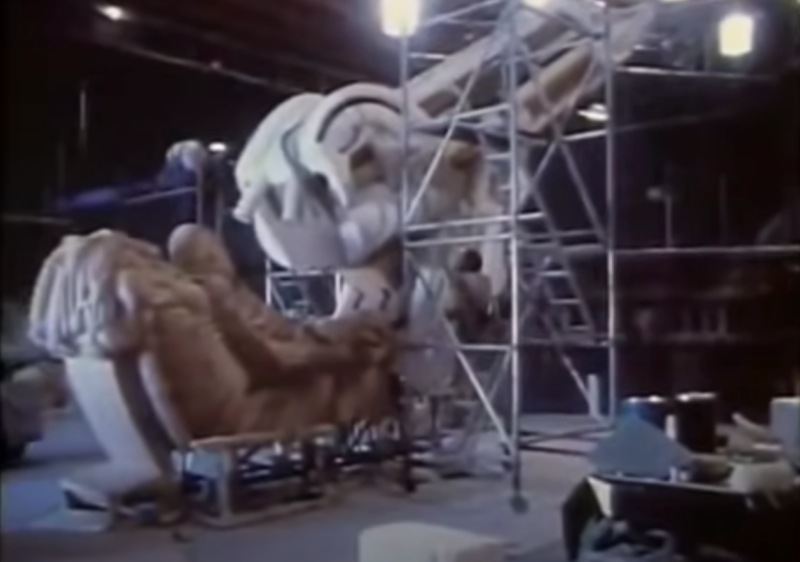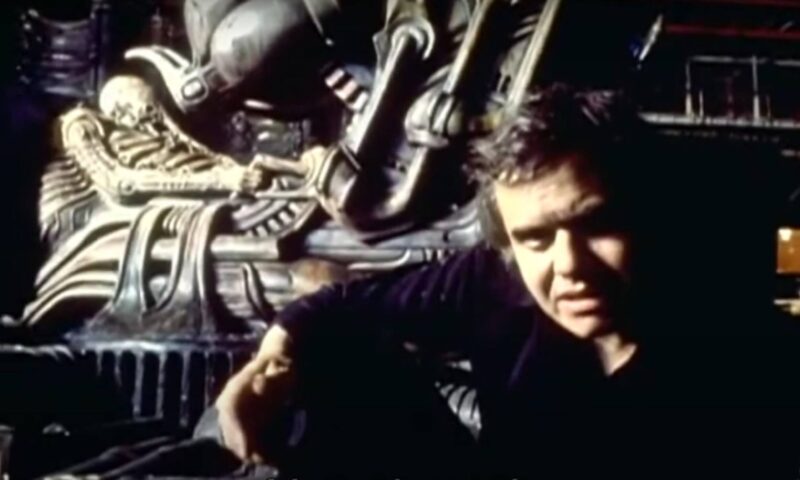
To mark Alien Day, we head back to the late 1970s to see how HR Giger designed the Space Jockey – and its strange fate after the film’s premiere…
In the early hours of Tuesday, the 29th May 1979, someone killed the Space Jockey. Burned it alive, perhaps with a blowtorch even something more mundane like a match or a cigarette. The crime occurred four days after the premiere of Alien at Hollywood’s Grauman’s Egyptian Theater, and was reported on by at least one outlet at the time: sci-fi magazine, Starlog.
“The Los Angeles opening of Alien was marked by misfortune when a miniature version of the film’s ‘starpilot’ was destroyed with fire,” the news story ran, garbling the Space Jockey’s name somewhat. “It was set ablaze by vandals just hours after being placed on display in the forecourt of Hollywood’s Egyptian Theatre. Additional objects on display in the lobby, including a transport vehicle seen in the film, were unharmed.”
The culprit was never caught, and to this day, nobody knows the motive for murdering the Space Jockey in its prime – mere weeks before it would become an unlikely cinematic icon.

“Looks like it’s been dead a long time…”
There are all kinds of unforgettable shots and moments in Alien, not least the scene that had audiences all over the globe throwing their popcorn in the air. But perhaps the greatest sequence of all – yes, even more so than John Hurt’s grisly fate – is the introduction of the Space Jockey.
Following a mysterious signal, the crew of the Nostromo send out a party to explore its source, traversing the howling storms of the moon LV-426 to discover a colossal derelict spacecraft. Venturing inside, the explorers find a huge chamber, seemingly a cockpit of some sort, in which sit the fossilised remains of the ship’s pilot.
“Alien life form – looks like it’s been dead a long time,” says Dallas (Tom Skerritt). “Fossilised. Looks like it’s growing out of the chair. Bones are bent outward, like he exploded from inside…”
As he says this, the camera pulls back to show the full chamber and the vastness of the creature’s form – hunched up, skeletal, seemingly biologically fused to its seat and the instrument panel that towers above it. The shot sums up everything that is brilliant and timeless about the film as a whole: the intelligence of its design and attention to detail; the way it manages to suggest so many dark, disturbing things with a single image.

For years after, the Space Jockey haunted imaginations. It posed all sorts of questions: how old was this creature? Could it stand up? What would it look like if it did? How did it get hold of all those eggs down there in the belly of its craft?
The power of the Space Jockey was such that it ultimately formed the basis of the prequel, 2012’s Prometheus, which did a lot to answer some of those questions. It’s telling, really, that it was the Space Jockey and its ship that would inform so much of Prometheus and not the actual Alien. (There are all kinds of critters in Prometheus; none look exactly like the monster that first haunted screens in 1979.)
Incredibly, the Space Jockey almost never happened. Although the discovery of a dead lifeform was described in the script, producers at 20th Century Fox repeatedly tried to convince director Ridley Scott to cut it. The film was already running over budget; did it really need the construction of yet another huge set-piece? Scott being Scott, he dug his heels in and insisted that it was vital to the story; instinctively, he knew that the film needed something foreboding – an image that would unsettle the viewer and hint at greater horrors to come.

The Space Jockey’s artistic father, ultimately, was the Swiss artist HR Giger. An eccentric albeit mild-mannered fellow, he’d been hired on the recommendation of co-writer Dan O’Bannon, who’d worked with him on Alejandro Jodorowsky’s doomed Dune project earlier in the 1970s.
It’s even possible that the Alien screenplay was partly inspired by Giger’s work; “His paintings had a profound effect on me,” O’Bannon later said. “I had never seen anything that was quite as horrible and at the same time as beautiful as his work. And so I ended up writing a script about a Giger monster.”
On the set of Alien, Giger struck an unusual figure; clad in a black leather jacket despite the hot summer of 1978, the artist worked feverishly in one corner of his workshop at Shepperton Studios, surrounded by clay, motorcycle parts and ill-smelling human and animal bones.
“Giger was very private,” Ridley Scott told me in 2017. “A great guy. I’m the only one allowed in there every day. I’d pop in there at about four o’clock in the afternoon for a cup of tea. He took the smallest stage in Shepperton, which is a 12,000 square foot stage. I gave him an entire studio to work in. He always wore black. I’ve never seen someone wear so much black. But then he was covered in white powder – chalk of some kind, from sculpting.”
Giger’s first experience of a Hollywood production, Alien wasn’t the creatively satisfying experience the 38 year-old artist had perhaps anticipated. There had been disagreements over pay and the boundaries of his job, and he’d often voiced his frustrations over how his ideas were transformed into physical sets and props. At one stage, Giger was stunned to find himself essentially released from his contract – then, a month later, he got a call from someone at 20th Century Fox to say he’d been hired again.
Read more: Ridley Scott revisited | Alien, and the personal touches that made it a classic
Despite Giger’s frustrations with producers and Fox executives, he enjoyed a more fruitful relationship with the artists charged with helping him bring his nightmarish ideas to life. Among them was Brian Muir, a British sculptor who’d previously worked on Star Wars two years earlier. Muir was at home when he got a call from fellow sculptor Peter Voysey; there was a sci-fi film called Alien in production at Shepperton, but plot details were a closely-guarded secret. Was he interested in lending his talents to the mysterious production?
“Although Giger was quite an enigma, I got on well with him,” Muir tells us. “I appreciated his airbrush techniques, which created almost 3D images. He was frustrated when things didn’t work out as he envisaged due to budget and censorship. He verbalised at the time how pleased he was with the work that Peter and I created.”
Among all the extraordinary creative talent working on Alien, though – and there really were some phenomenal artists on it, from Scott on down – HR Giger was arguably the most pivotal. One incident from the production in particular illustrates just how profound his influence on the film was.
The derelict
In early 1978, Giger was staying at a pokey London flat when he awoke in the early hours from an uneasy night’s sleep. Feeling restless, he got up and started painting. With airbrush in hand, he began rendering an idea he’d had rattling around in his mind for a while: that of a U-shaped alien ship that looked as though it had been grown in some colossal lab. By the time his girlfriend (and later wife), Mia Bonzanigo had woken up, the painting was finished. It was what would become the derelict – the huge alien ship the crew of the Nostromo finds in the finished film. The ship that once belonged to the Space Jockey.
It’s how Giger commonly worked: his darkly surreal paintings were rendered spontaneously, as though they were beamed in directly from his own nightmares. The twist was that Giger was also technically gifted enough to understand how these unearthly shapes could then be turned into physical objects.
Such was the case with the derelict, which, after a bit of a battle with other creative minds on the film – O’Bannon and executive producer Gordon Carroll didn’t want it, but director Ridley Scott did – Giger’s design was finally accepted as the one that would be used in the finished film. Giger then sculpted a scale model based on his painting, which in turn was turned into a larger construction by Muir and Voysey.

The shot of the derelict in the final movie, right down to the wispy atmosphere and camera angle, is exactly like the painting Giger painted in an Old Church Street flat in 1978. The crashed ship emerged straight from Giger’s imagination and unfurled on the screen, fully-formed.
A similar thing happened with the Space Jockey. Ridley Scott often turned to Necronomicon, a book of Giger’s work published a few years earlier, for inspiration – the Alien itself was famously taken straight from a painting in that book called Necronom IV. For what would become the Space Jockey, Scott pointed to another piece of Giger’s artwork and gave the artist a rough thumbnail sketch of what he wanted.

Giger then went away and, in March 1978, painted two images of the pilot: one showing the full, circular chamber and its huge chair from the rear; the other depicting the Jockey from the side. Again, these were turned into a small 3D model, which was then scaled up to a huge set piece measuring some 26 feet high.
It’s unclear where the Space Jockey nickname came from; Muir recalls that it was a name regularly used on-set, but doesn’t “remember any talk of the origin of the name.” It’s just possible it came from one or Ridley Scott’s early thumbnail sketches, in which the pilot is seemingly astride its telescope-like apparatus, much like a jockey riding a horse.
Whatever the origins of the nickname, the Space Jockey was an expensive and time-consuming set piece to construct; Muir recalls that he and Voysey spent some four weeks working on it. The cost of the entire thing weighed in at about $500,000 – a not insignificant chunk of the finished film’s $11m budget.
The pilot and its seat were initially sculpted from clay by Voysey; this was then turned into a plaster cast, which in turn was used as a mould for the polyester body. The rest of the seat and the Space Jockey’s ‘telescope’ were made from styrofoam, with the whole thing mounted on a sturdy metal frame.

Giger himself was hands-on during the process. Clambering up on a scaffold, he painted the Space Jockey’s body with a layer of sepia-toned paint, then overlaid this with a glaze of latex rubber.
“The latex is liquid, like milk,” Giger wrote in his diary. “When it dries it becomes a thin, transparent skin, and I smooth it down here and there with my hand. What I’m aiming at is the impression of a porous, decayed skin.”
Those words were written on the 25th September 1978 – the day before Scott and his team were due to start filming. The Space Jockey was almost ready for its closeup.
As lights were arranged and cameras were positioned on the 26th September, a crewmember doused the Space Jockey with stage smoke. “It smells horrible and makes it very stuffy on the stage,” Giger wrote. “The lighting men crouch in the scaffolding bathed in sweat and light up whatever they are told…”
To make the Space Jockey look even more imposing, Scott and his collaborators cleverly dressed up three children – two of them the director’s own young sons – in miniature space suits. It immediately gave the illusion of a larger set without burning through more of the tight budget, though the heat on the soundstage was such that one of the youngsters almost passed out in their heavy costumes.
Giger often voiced his frustrations with some of the money-saving decisions made on set. The backdrop for the Space Jockey and its cockpit, for example, doubles as the background for the egg silo (“This doesn’t strike me as at all reasonable,” Giger grumbled at the time). It’s arguable, however, that these sequences are so atmospherically staged that the cost-saving barely figures in the finished film.

Screen burn
Muir recalls sitting with the rest of the crew for a private, pre-release screening of Alien, and thinking that it was “as scary and sexual as I thought it was going to be while I was working on the production.”
Fox evidently knew it had a hit on its hands, since it spared little expense on Alien’s premiere, held on the 25th May 1979. Numerous props, set-pieces, Giger paintings and scale models were shipped over from the UK to Los Angeles for the event – including, of course, the Space Jockey.
On entering Grauman’s Egyptian Theater, movie-goers had to pass through the ‘Mother’ set – the gigantic, twinkling computer mainframe that sustained the Nostromo – in order to get to the lobby. There, they’d find scale models of the Space Jockey’s cockpit and egg chamber, life-size alien eggs, and a full-scale ‘planetary rover’ briefly seen in the film.
The Space Jockey, meanwhile, was so large that it was kept out in the cinema’s courtyard. One photo taken around the time shows Ridley Scott being interviewed by a TV crew in front of its swooping, skeletal form. Incredibly, the set-piece wasn’t even roped off – one photograph from the premiere, taken by author Lisa Morton, shows a friend of hers reaching out and touching it.

Someone else at the premiere that May was William Malone, a sculptor and filmmaker who would later collaborate with HR Giger on his own movie projects in the 1980s. Malone took several photos of the props and set-pieces dotted around the cinema (you can see two of these below), and was similarly alarmed at the lack of protection around these irreplaceable pieces of artwork.
“I remember the day I was there shooting those pictures, somebody took a chunk of styrofoam out of the Space Jockey,” Malone tells us. “And I called up 20th Century Fox, because I had friends over there, and I said, ‘You gotta put security on this stuff because something bad’s gonna happen.’ You could just walk up to it.”
Four days later, the Space Jockey was destroyed in circumstances that are still uncertain today. Giger simply records in his diary that the set-piece was burned by a ‘pyromaniac’. Brian Muir highlights that there are two versions of events: the first is that it had been “purposely set alight by someone who did it for religious reasons”.
The second, more mundane theory is that someone simply left a “cigarette burning on the sculpt” – and given that the Space Jockey was made almost entirely of combustible materials, it soon went up like a Roman candle. Lisa Morton tells us that she’s heard “conflicting stories about the fate of that magnificent piece. The first stories I heard said it was arson, but I’ve since heard it was an accident.”
William Malone, meanwhile, argues that it almost certainly wasn’t an accident. “From looking at it, I’d say someone would have had to have purposely set it on fire,” he says. “I don’t think setting a match or a cigarette on it would have done it. I think somebody set fire to it just to see if it would burn or something… It was a such a beautiful piece. A beautiful work of art. We share this planet with a bunch of pinheads, I’m afraid.”
Whatever the cause, the fire wiped out both the Space Jockey and several full-scale alien eggs sitting nearby.
Just like that, a true work of baroque art was gone forever.
By the time the Space Jockey had been reduced to a pile of ash, however, its place in film history was already assured. Regarded as a landmark in genre film history, Alien was a major hit, spawning a franchise that is still going 45 years on. Alien: Romulus, a prequel that draws heavily on the original film’s imagery, is due out in August.


One of the major reasons for Alien’s enduring success is its level of artistry. Giger, who said in his diaries that he was ‘counting down the days’ to the end of production, certainly realised he’d been part of something special. “One thing I know for certain,” he wrote, “Alien will be an extraordinary film, possibly a classic among horror science fiction films.”
Eighteen months later, Giger was stunned to find himself on stage at the Academy Awards, having been handed an Oscar for Alien’s visual effects. It was just recognition, given that so much of the film’s power revolved around his art.
As for the Space Jockey, the ossified creature still has an otherworldly power. Brian Muir regularly makes appearances at sci-fi conventions today, and it’s the photos of the Space Jockey that people commonly single out and remark on.
“I think the Space Jockey adds mystery to the story and works well visually,” Muir says. “I don’t think it would have been quite the same without this iconic piece that is so memorable in the minds of fans.”





